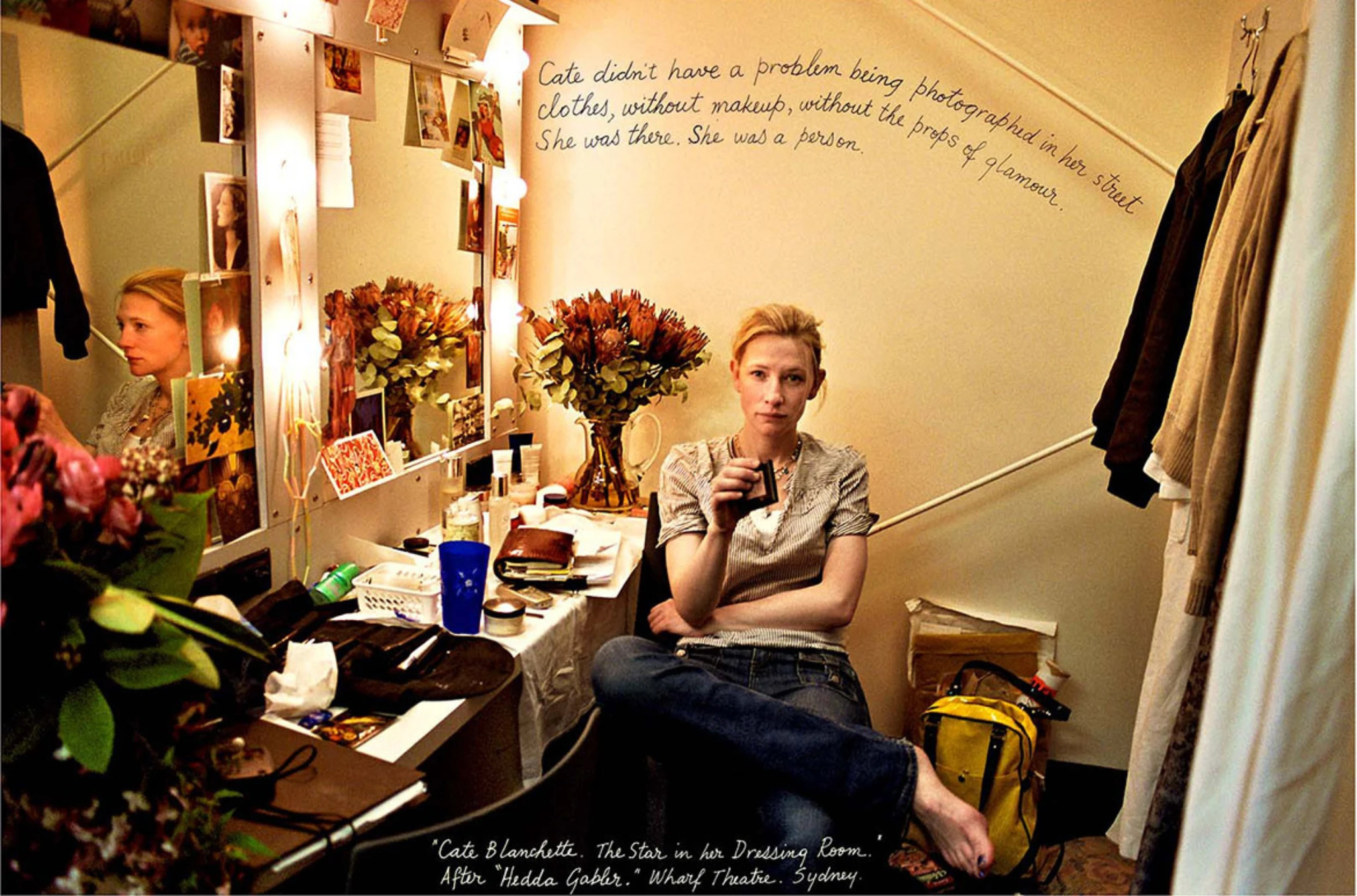18th October, 2024
Background on Photographer William Yang
William Yang is a renowned Chinese-Australian photographer, writer, and performer born in 1943. Born in Queensland and based in Sydney, his career spans over five decades. He has made significant contributions to portraiture photography, particularly in documenting gay Australia and exploring themes of identity, sexuality, and cultural heritage. Notably, Yang captured some of the most famous faces in Australian theatre, film and art, and became “a much-loved and trusted figure who is embedded into Sydney’s social fabric” (Queensland Art Gallery).1,2

Yang’s work is characterised by an enticing collaboration between photography and storytelling. He often incorporates text directly into his photographs, creating a narrative that complements the visual image. This technique, which he developed in the late 1980s, became a signature aspect of his style. According to Queensland Art Gallery, Yang often asked his ‘sitter’ a series of questions while shooting, “and they would reveal more of themselves than they would during the course of a casual conversation.” Yang’s intimate process for portraiture contributes to the value of his work.3
Cate Blanchett: The star in her dressing room. After Hedda Gabler. Wharf Theatre. Sydney. 2004

This photograph captures Cate Blanchett in an intimate, behind-the-scenes moment, in her personal dressing room. This photograph shows Blanchett in casual clothing, surrounded by personal items.
As in many of Yang’s portraits, there is text placed within the frame, giving it further context and characterisation:
Cate didn’t have a problem being photographed in her street clothes, without make-up, without the props of glamour. She was there. She was a person.
Composition
Yang’s portraits often focus on capturing his subjects in their natural environments. A wide aperture allows the viewer to place Blanchett among her dressing-room items. Yang has employed the rule of thirds, with Blanchett on the right side of the photograph, framed by a rack of clothing just out of frame, a decorated dresser. We can see recognisable depictions of Blanchett in photos on her dresser, juxtaposed by her intimate, unposed presence. The frame contains the text, achieving a deliberately cluttered effect and enticing us to read. The dresser provides a leading line, the bars on the back wall provide further instruction, and the bouquet next to Blanchett’s face serve as a secondary subject, inviting us to ponder the decorated dresser, and Blanchett’s reflection – further emphasising the idea of public and personal identity.
Technique
While Yang does not provide specific technical details for this photograph, his straightforward, documentary-style approach to photography is well-known. Based on the resolution of the photograph, and information on his other works, this photograph was likely taken on a digital camera current to 2004. The focal length suggests the use of a 35-50mm lens. Yang often uses available light to create a natural, unposed feel in his portraits. This photograph seems to be no exception. The lighting in this photograph is dim, and the subject is lit partially by the mirror lights. Areas away from Blanchett, at the bottom and sides of the frame, are dimmer, which further emphasises her as the focal point.4
Subject Matter & Artistic Intentions
The photograph depicts Cate Blanchett, a prominent Australian actress, in her dressing room after a performance of Hedda Gabler at the Wharf Theatre in Sydney. This subject matter is significant, as it captures a moment of transition between the public and private persona of a celebrated artist. Yang’s work often aims to explore identity and capture authentic moments. In this photograph, he likely sought to reveal a more personal side of Blanchett, contrasting with her public image as a star.5,6
Portraiture: Where does this photograph align?
This work aligns with Yang’s approach to portraiture, which often involves capturing subjects in their personal spaces or professional environments. It exemplifies his ability to create intimate portraits of public figures. Some of his other works take a more formal approach, but the photo in question is an environmental one. The added text adds an element of storytelling, placing the photo as an example of documentary portraiture.7
Contextualisation
Historical Context
The photograph was taken in 2004, a time when Blanchett was establishing herself as a major international star. During this time, she frequently appeared on red carpets and attended premieres, or wore costumes for films or plays. Here, Yang has taken his usual approach in creating an image that reflects an intimate and genuine portrayal of the star as “a person”. Although we don’t know the story behind this particular photograph, Yang’s perspective as an “outsider” (culturally and in terms of sexual orientation) influenced him. As Alasdair Foster puts it, this positions Yang’s work as “subtle, melancholic and gentle but incisively authentic.8,9

Cultural Context
Yang’s work is deeply influenced by his identity as a gay, Chinese-Australian artist. While this specific photograph may not directly address these themes, it is part of Yang’s broader body of work that explores Australian culture and identity.

In an interview with ArtsHub, Yang commented that Australian culture finds personal narratives in storytelling more enticing than audiences he has exhibited to in China. “They find a personal story a bit alien, because culturally they are more communally minded.” Grappling with identity within a bi-cultural and queer framework undoubtedly led Yang to dedicating his photographic career to humanising public figures and showing hidden versions of their lives.1011
Personal Reflection
I began writing the report after having the idea of taking environmental portraits of my friends in their rooms. I was interested in drawing out the relationship between their personalities and their personal items within the space they live. Yang’s work is a fantastic example of how portraiture can reflect an intimate understanding of the person photographed. William Yang ‘Cate Blanchett. The Star in Her Dressing Room. After Hedda Gabler. Wharf Theatre, Sydney’ 2004, will support my own photographic concept for this project. It is a meaningful example of how the sitter might interact with their environment, through choosing what is in the frame and where the subject is within it. The photo exemplifies how a room can provide natural context in leading a viewer through the subject’s personhood, and I will consider the compositional opportunities that a space provides while shooting my series.
References
- Frost, A. (2016) ‘Photographer William Yang on five decades of recording gay Australia’, The Guardian, 19 February. Available at: https://www.theguardian.com/artanddesign/2016/feb/19/photographer-william-yang-on-five-decades-of-recording-gay-australia (Accessed: 17 August 2024). ↩︎
- Queensland Art Gallery | Gallery of Modern Art (QAGOMA) (n.d.) ‘William Yang: Australian celebrity and portraiture’, QAGOMA Blog. Available at: https://blog.qagoma.qld.gov.au/william-yang-australian-celebrity-and-portraiture/ (Accessed: 17 August 2024). ↩︎
- Frost, A. (2016) ‘Photographer William Yang on five decades of recording gay Australia’, The Guardian, 19 February. Available at: https://www.theguardian.com/artanddesign/2016/feb/19/photographer-william-yang-on-five-decades-of-recording-gay-australia (Accessed: 17 August 2024). ↩︎
- Frost, A. (2016) ‘Photographer William Yang on five decades of recording gay Australia’, The Guardian, 19 February. Available at: https://www.theguardian.com/artanddesign/2016/feb/19/photographer-william-yang-on-five-decades-of-recording-gay-australia (Accessed: 17 August 2024). ↩︎
- Frost, A. (2016) ‘Photographer William Yang on five decades of recording gay Australia’, The Guardian, 19 February. Available at: https://www.theguardian.com/artanddesign/2016/feb/19/photographer-william-yang-on-five-decades-of-recording-gay-australia (Accessed: 17 August 2024). ↩︎
- Stratton, D. (2008) ‘Beyond recognition’, The Age, 13 September. Available at: https://www.theage.com.au/entertainment/movies/beyond-recognition-20080913-ge7dm4.html (Accessed: 17 August 2024). ↩︎
- Queensland Art Gallery | Gallery of Modern Art (QAGOMA) (n.d.) ‘William Yang: Australian celebrity and portraiture’, QAGOMA Blog. Available at: https://blog.qagoma.qld.gov.au/william-yang-australian-celebrity-and-portraiture/ (Accessed: 17 August 2024). ↩︎
- Stratton, D. (2008) ‘Beyond recognition’, The Age, 13 September. Available at: https://www.theage.com.au/entertainment/movies/beyond-recognition-20080913-ge7dm4.html (Accessed: 17 August 2024). ↩︎
- Talking Pictures (2021) ‘William Yang: Stories from the margin’, Talking Pictures, 16 October. Available at: https://talking-pictures.net.au/2021/10/16/william-yang-stories-from-the-margin/ (Accessed: 17 August 2024). ↩︎
- Frost, A. (2016) ‘Photographer William Yang on five decades of recording gay Australia’, The Guardian, 19 February. Available at: https://www.theguardian.com/artanddesign/2016/feb/19/photographer-william-yang-on-five-decades-of-recording-gay-australia (Accessed: 17 August 2024). ↩︎
- ArtsHub (2021) ‘Q&A: Artist William Yang on growing up gay and Chinese’, ArtsHub, 16 October. Available at: https://www.artshub.com.au/news/features/qanda-artist-wiliiam-yang-on-growing-up-gay-and-chinese-261991-2370109/ (Accessed: 17 August 2024). ↩︎





